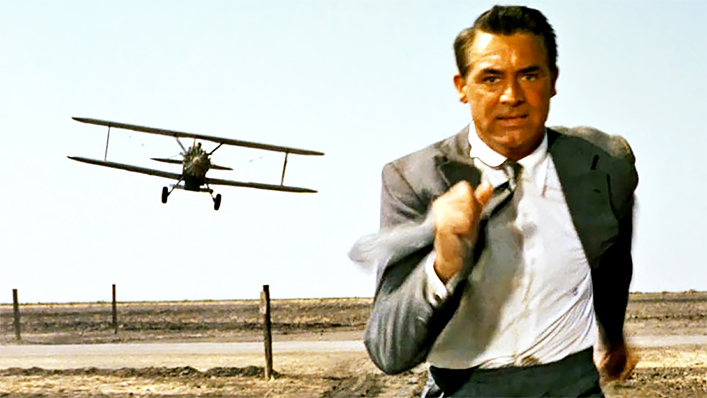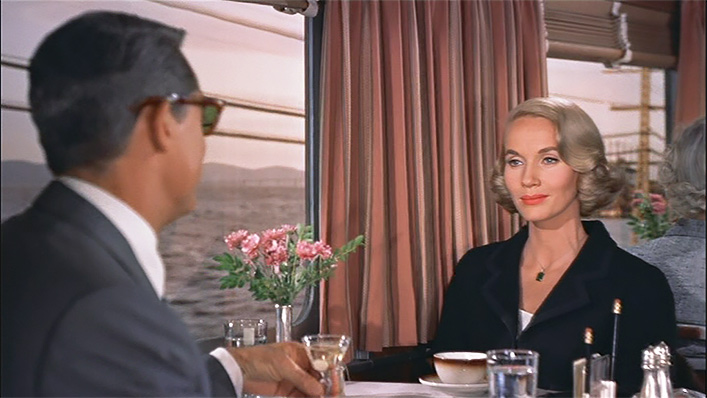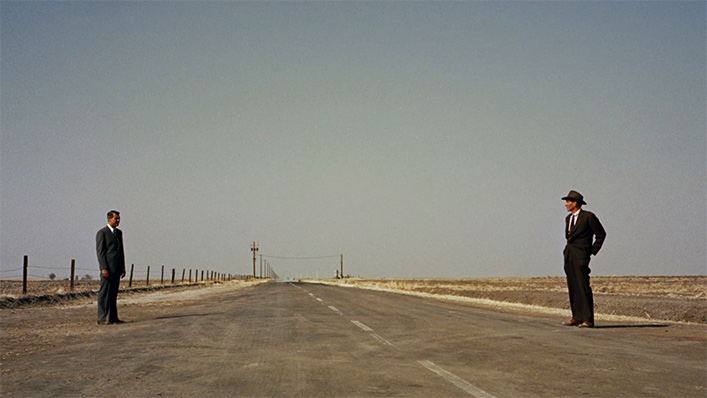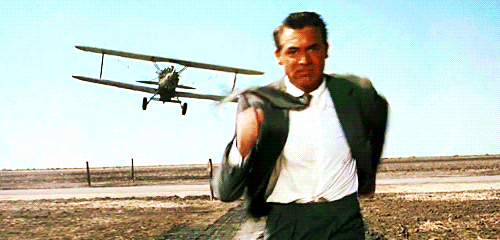60 years ago, Alfred Hitchcock delivered one of cinema’s perfect scenes in North by Northwest

The famous crop-dusting sequence in North by Northwest is one of the greatest scenes from Alfred Hitchcock, and thus one of the greatest scenes in cinema. To mark the film’s 60th birthday, Sarah Ward revisits this amazing moment.
A plane swoops, veering closer to the ground than it usually would. A man runs, his furrowed brow glistening and his crisp grey suit ruffling from the effort. And so, amid dusty fields on a deserted road a bus ride out of Chicago, one of cinema’s iconic scenes is born. First reaching the silver screen in June 1959, it’s now 60 years old.
North by Northwest’s crop-dusting sequence has been parodied by The Simpsons and pilfered by From Russia With Love, to name just two pop culture properties that have nodded in its direction. The sight of Cary Grant sprinting as the agricultural aircraft bears down behind him is one of celluloid’s enduring and instantly recognizable images. Across its ten minute running time, the scene also ranks among Alfred Hitchcock’s most memorable moments. This is no minor feat; the master of suspense already had a three-decade resume when he made this tense and thrilling film, and still had Psycho and The Birds to come.
Along with the latter duo’s stab-happy shower frenzy and dive-bombing avian attacks, North by Northwest’s centrepiece is one of the acclaimed director’s scene-level highlights; however its standing within the film itself is equally noteworthy. In a feature that casts Grant as a New York advertising executive mistaken for a government agent, then chased partway across the country as he attempts to clear his name, the crop duster altercation represents the entire movie in a microcosm.

Both unfurl a game of cat and mouse that bobs, weaves, glides, falls, surprises and intrigues. Both take the time needed to allow the reality of Roger Thornhill’s treacherous predicament to sink in, without ever letting a second go to waste. Both bring a twist-filled narrative to life with Hitchcock’s pinpoint visuals and pacing – aided by his regular cinematographer Robert Burks and editor George Tomasini – while demonstrating that resting easy, even for a second, is a dangerous folly.
Landing an hour into the film, the sequence arrives with ample context about Thornhill’s struggle to prove that he’s not a spy by the name of George Kaplan. After being abducted by Phillip Vandamm’s (James Mason) henchmen, interrogated in Long Island, then plied with liquor and placed behind the wheel of a car in an elaborate attempt on his life, Thornhill is eager to resolve the mix-up. He’s then picked up by police, charged with drunk driving, and thought a fool by his mother (Jessie Royce Landis), increasing his motivation and desperation. Next, Thornhill tracks his assailants to the United Nations, only to be framed for a diplomat’s murder. On a train to Chicago, he makes Eve Kendall’s (Eva Marie Saint) acquaintance, with the alluring blonde not only helping him hide from the law, but organising his rural stopover.

As such, the scene is set for a showdown. One comes, but it’s how North by Northwest relays this section of Ernest Lehman’s script that matters. Hitchcock was never one for empty storytelling, or for eschewing the cinematic form to convey a narrative, his every creative choice teeming with purpose. Here, doing what he does best, he pairs hard-earned suspense with rousing action.
It’s with an air of foreboding that the film looks down as Thornhill’s bus approaches a remote stop, with nothing else in sight in the aerial view but dirt. Noticeably, the scene is quiet; while Bernard Herrmann’s needling score roars through much of the movie, amplifying the terse tone, Hitchcock opts for just road and air noise here. Also evident is Hitchcock’s determination to ground his protagonist in his sparse environment, with the brown expanse of soil, and the dusky grey-blue sky above it, always apparent. As Thornhill waits, the audience is made constantly aware of his isolation. Extreme wide shots dominate. Even when the camera peers closer – never closer than mid-shots – his location is always visible.

The feature doesn’t stare deeply into Thornhill’s eyes; however it’s easy to spy his agitation. As the fields behind him remind viewers, he’s out of his comfort zone. With a back-and-forth pattern, alternating between the road and the main standing along in its midst, Hitchcock ramps up the tension to match the unease. Cars pass, one emerging from behind a crop of corn to deliver a man. The suspense ratchets up, with the film still choosing not to venture too close. In one striking shot, the two men are each pushed to opposite sides of the frame with a world of space between them. A gap that, like the sequence’s silence, reveals much in its emptiness.
Alas, the stranger is just awaiting the next bus. It’s this unnamed man who highlights the crop duster and its strange behaviour: “that plane’s dusting crops where there ain’t no crops,” he comments. A teased-out atmosphere permeates their conversation, though that’s the entire scene in a cornstalk. Once he’s gone, the plane swoops and attacks, reclaiming the sequence’s to-and-fro nature. There should be a semblance of coziness in the routine of watching Thornhill, then spotting the plane, then repeating, but the film never settles into a rhythm. Instead, it radiates anxiety.

When Herrmann’s simultaneously melodic and jittery score eventually kicks in, it perfects the mood. More than that, it complements Grant’s performance. There’s both smoothness and edginess to the entire ten minutes, and to Grant’s efforts within it. He’s suave and rumpled at once, whether he’s merely standing in wait or fluidly falling to the ground. The entire movie proves one of his best thanks to more than just one scene, but it’s a killer showcase for his talents nonetheless.
From Saul Bass’ kinetic opening titles, to the UN-set murder, to the seductive train rendezvous, to the climax set around and atop Mount Rushmore, every aspect of North by Northwest is masterful. As an antic-filled dive into Cold War-era espionage, it smartly interrogates suspicious times and social mores. As an on-the-run thriller, it doesn’t let its momentum lapse. It’s as classic Hitchcock as the filmmaker gets, because there’s no such thing as classic Hitchcock; even when he deploys familiar techniques, they’re never the same twice.
Sixty years on, every element of this movie holds up, including Grant and Saint’s silky banter, as well as his stellar drunk acting. It’ll always be remembered for the crop-dusting scene, however – a scene that, like the film itself, truly soars.

















